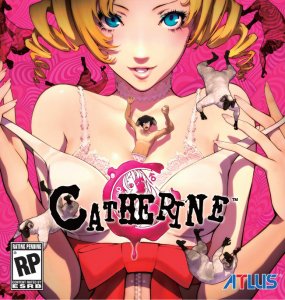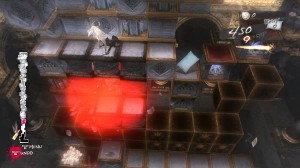The challenge of a game review is to write for those who are interested in the game while still explaining the core concept of the game to those who may not know. I use no hyperbole in saying I had to rewrite portions of this review of Catherine two or three times before I felt that I didn’t sound like a complete lunatic to those unfamiliar with the game. In a way, this is analogous to Catherine as a whole; it’s inexplicably hard to explain, but I feel those who actually do “get it” won’t really know why. While this uniqueness is possibly the best thing Catherine has going for it, it still flounders in parts due to some limited character development, gameplay repetition, and downright baffling story turns. That being said, I still think anyone who wants something new should play Catherine, if only to see just how different it really is from anything else out there right now.
The actual game part of Catherine is almost secondary to the story starring an indecisive twenty-something named Vincent, who is finally getting pressured by his girlfriend (Katherine) to settle down with her. This startles Vincent–as it does twenty-somethings–who wants only to keep the same job, go to the bar after work with his buddies, and chain-smoke his way into dreamland. One of these decedent nights leaves him with the last thing he needs: a hot (for an anime girl) young blonde girl named Catherine. To make matters worse, rumors have been going around of cheating men dying in their sleep during certain nightmares; the same nightmares Vincent is having, and the nightmares you play through for pretty much the entirety of the game.
When you are actually playing Catherine, you partake in one of two scenarios: one is the aforementioned bar Vincent goes to after work. You can walk around and talk to different patrons about different side stories, or your own friends about what’s going on in your weird, obviously-written-by-RPG-developers life. Vincent will also get text messages from both of the C/Katherines, and you can respond in a number of preset ways. This, along with questions you answer at the end of your dreams, are part of a barely and somewhat poorly explained morality system which will help determine your ending. This is essentially the “dating sim” aspect of the game, but don’t take it too literally; the story is linear no matter how far you want Vincent to sway. There will be times where you want to slap him and tell him to make up his man-baby mind. This is normal, just know it going in.
This leaves us with the game-y part of Catherine, which some will argue is the least appealing part of the experience. Basically, you play through Vincent’s dreams along with other anthropomorphic sheep (anime, folks), trying to reach the top of a tower while the blocks making it up crumble below you. In some weird Q-Bert and Intelligence Cube mash-up, you push and pull blocks in and out of place in order to climb. Like any good puzzle, though, these blocks have certain properties. You can only climb up one at a time, and they can lock into place by placing one block in front or to the side of another. Once you get the basics of this down, the game starts becoming a little more complicated: as long as an edge of a block is touching another, it will still lock into place. This leads to a lot of pulling blocks out of place to lower something in front of you and pushing other blocks all the way to the edge of where you are to make enough room to ascend. It’s hard to explain, and even harder considering some of the power-up blocks that show up that can do anything from blow you up to launch you up five stories. Like the English language, there is an exception for every rule.
If what I just described doesn’t sound exactly fun to play, that’s because, at times, it’s not. But something about Catherine kept making me coming back. I wanted to know how the love triangle would turn out between these people I could *almost* identify with. I was fascinated that a game could be about relationships without being all JRPG about it and be about sex without showing boobs every five minutes. The story does take a strange, strange turn near the end, however, and that’s about the time you realize this was indeed made by people who make JRPGs. It’s also a shame that the interaction between both of the lovely ladies in your life is so limited. I would have liked to have spent more time getting to know these characters than trying to get to the bottom of the weirdly rumored deadly nightmares. If playing something new isn’t enough for you to invest in a game, Catherine may not be for you. If you want something so new there should be a new word for the new-ness of it, Catherine is worth experiencing.





